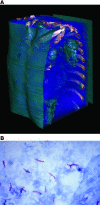Confronting the scientific obstacles to global control of tuberculosis
- PMID: 18382738
- PMCID: PMC2276805
- DOI: 10.1172/JCI34614
Confronting the scientific obstacles to global control of tuberculosis
Abstract
Tuberculosis (TB) is a major threat to global health, recently exacerbated by the emergence of highly drug-resistant forms of the disease-causing pathogen and synergy with HIV/AIDS. In 2006, the Stop TB Partnership published "The global plan to stop TB: 2006--2015," which set out a vision of halving the prevalence of and mortality caused by the disease by 2015, followed by eliminating the disease as a public health problem by 2050. This vision depends on the development of improved diagnostics, simpler treatment, and more effective vaccination. Recently, active translational research pipelines directed toward each of these goals have been established, but improved understanding of the fundamental biology of this complex disease will prove to be the key to radical advances in TB control.
Figures


References
-
- [Anonymous]. 2004. World health report 2004: changing history. WHO. Geneva, Switzerland. http://www.who.int/whr/2004/en/report04_en.pdf.
-
- [Anonymous]. 2007. Global tuberculosis control — surveillance, planning, financing. WHO. Geneva, Switzerland. http://www.who.int/tb/publications/global_report/2007/download_centre/en....
-
- Girardi E., Raviglione M.C., Antonucci G., Godfrey-Faussett P., Ippolito G. Impact of the HIV epidemic on the spread of other diseases: the case of tuberculosis. AIDS. 2000;14(Suppl. 3):S47–S56. - PubMed
-
- Selwyn P.A., et al. A prospective study of the risk of tuberculosis among intravenous drug users with human immunodeficiency virus infection. . N. Engl. J. Med. 1989;320:545–550. - PubMed
Publication types
MeSH terms
Substances
Grants and funding
LinkOut - more resources
Full Text Sources
Other Literature Sources
Medical
Molecular Biology Databases

